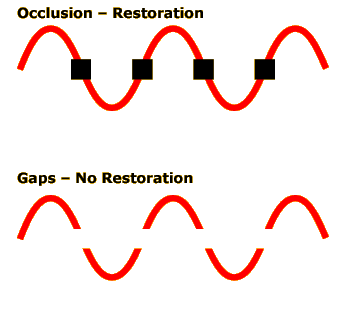Continuity and Restoration Effects
Introduction - Auditory Good Continuation
Our auditory world, like our visual world, is a crowded place. When one visual object covers another object from view, we say that the object in front occludes the object in back. As we saw in Chapter 4, the visual system is remarkably good at dealing with occlusion. Presented with a visual stimulus such as the one at top left, we fill in behind the occluders, making the assumption (which is almost always valid) that the red sine wave continues on behind the black squares. Human infants appear to begin making these assumptions at a very early age (see the activity on Infant Object Perception).
An analogous process is at work in the auditory system. Click the small triangle to play the top sound at left (the one under the occluded sine wave). You will hear a gliding tone, an auditory analog of the visual stimulus above it. Bursts of white noise serve as the auditory "occluder" in this sound, but as with the visual stimulus, you should hear the gliding tone continuing right along behind the noise. This is an auditory equivalent to the Gestalt principle of good continuation, so it is sometimes called a continuity effect.
Now consider the image and sound at bottom left. Without the black squares to act as visual occluders, we tend to see five distinct curves here (although your visual system might try to create an occluding horizontal bar out of illusory contours). Play the bottom sound and you will hear the auditory analog. With silent gaps replacing the bursts of noise, you should hear five separate auditory objects, rather than the single continuous glide you heard in the top sound.
Phonemic Restoration
Vision researchers have found neurons that respond to objects in exactly the same way whether they are occluded or not. Similarly, auditory neuroscientists have found neurons in primary auditory cortex that respond to gliding tones such as the ones in the previous part of the activity equivalently, regardless of whether the glides are interrupted by noise or not. However, when the glides are interrupted by silent gaps, the neural responses decrease.
Taken in this context, we can call these restoration effects, since the auditory system is "restoring" the portions of the background sound that are being destroyed by the noise.
In addition to relatively simple sounds such as gliding tones, restoration effects have been shown to be just as, if not more, powerful for complex sounds such as speech. For example, play the top sound at left (Sentence 1) to hear the first sentence of Dr. Seuss’ The Cat in the Hat read aloud. Bursts of white noise will obliterate two of the phonemes (speech sounds) in the sentence. After listening to the sentence once, click inside the blue rectangle to place arrows where you think the noise occurred. Then click the SHOW NOISE LOCATIONS button to reveal the actual locations of the noise bursts.
Next, do the same thing for Sentence 2. Here, silent gaps, rather than noise, replace two phonemes. Again, after listening to the sentence once, click inside the blue rectangle to indicate where you think the gaps occurred. Then click the SHOW GAP LOCATIONS button to reveal the actual locations of the silent gaps.
You may find that you were more accurate at locating the missing phonemes when noise, rather than silence, covered the phonemes, a result that has been found in a host of experiments conducted since the early 1970s. Think about the implication of this result. The fact that it is harder to know what is missing when the phoneme is covered by noise than by silence means that your auditory system is better at restoring the missing speech sounds when they are covered by auditory occluders, just as it was with the gliding tones in the previous part of the activity.
You may have experienced a similar effect in real life while using your cell phone. When you or the person you are talking to has bad reception, your conversational partner's voice cuts in and out, with silent gaps intervening, and it is often very difficult to make out what they are saying, even if the gaps are relatively small. It is possible that it would actually be easier to understand such choppy speech if cell phones automatically filled in the gaps with some type of noise.





